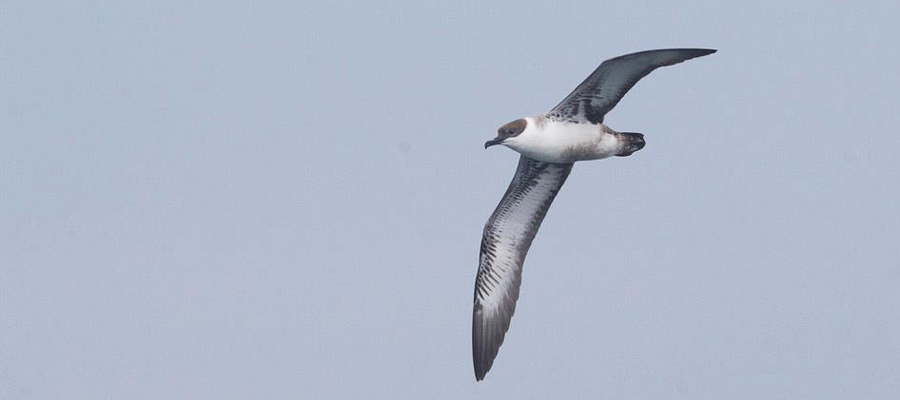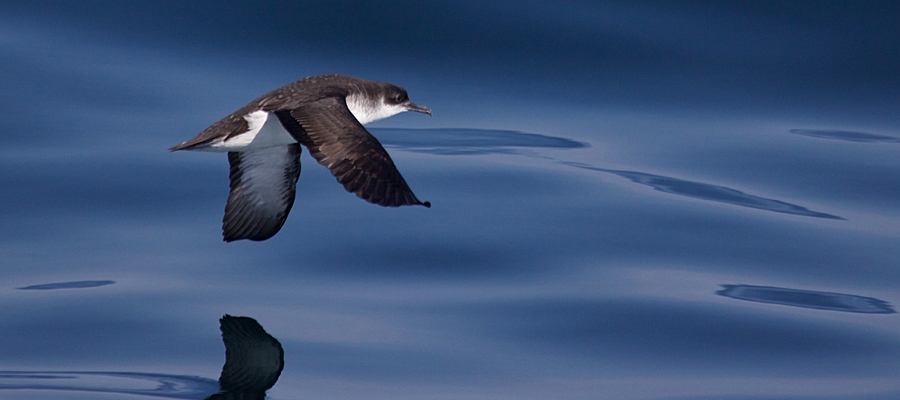SHEARWATERS & PETRELS
The exact number of Shearwater and other Petrel species you may see while whale watching off the coast of Gloucester varies A LOT from week-to-week, month-to-month, and year-to-year. Just as with the whales, the abundance of these birds is food-dependent, and so at times, you may see literally thousands of Shearwater and Petrels on just a single trip while at other times birds are very few and far between. All that being said, here’s a rough estimate of average abundance:
SHEARWATERS
Greater Shearwater : Abundant (75-99% of trips)
Sooty Shearwater : Common (50-74% of trips)
Manx Shearwater : Fairly Common (25-49% of trips)
Cory’s Shearwater : Uncommon (1-24% of trips. In some years more common)
Audubon’s Shearwater : Very Rare (no confirmed sightings)
PETRELS
Wilson’s Storm Petrel : Abundant (75-99% of trips)
Leach’s Storm Petrel : Rare (less than 1% of trips)
Five species of Shearwaters and two species of Storm Petrels have been seen in the Stellwagen Bank/Jeffrey’s Ledge area by birders aboard 7 Seas Whale Watch boats. Of the five Shearwater species I can confidently say I’ve seen four of them: the Greater Shearwater, Sooty Shearwater, Manx Shearwater, and Cory’s Shearwater. The fifth species, the Audubon’s Shearwater, was reported by a very accomplished birder friend of mine so I’ll include this very rare, warm-water species in our list of possibilities.
Of the four “regular” species Greater and Sooty are by far the most common. Both of these species “winter” in this area during the northern hemisphere summer. In the Fall these birds will migrate all the way to the South Atlantic to breed on remote sea islands such as the Malvinas (or “Falklands”), South Georgia and the South Sandwich Islands in the South Atlantic (a Pacific population of Sooty shearwaters also breed off eastern Australia and the Philippines). So although we see these birds in May through September in our as far these birds are concerned it’s winter-time and breeding is the last thing on their minds. It is amazing to look at a Greater or Sooty Shearwater on Stellwagen Bank and think of how many miles of ocean that bird has covered… they are truly accomplished ocean wanderers.
GREATER SHEARWATER
Greater shearwaters can be recognized by their relatively large size (just smaller than a Herring Gull), brown backs, white napes, and dark caps that contrast sharply with their white throats and undersides. A keen-eyed observer will also note that when a Greater shearwater banks and exposes its ventral (under) side there is a dark “smudge” on the otherwise white belly.
SOOTY SHEARWATER
Sooty shearwaters are slightly smaller and thinner-winged that Greater shearwaters and can be readily identified by their all sooty-brown coloration. The only lighter feathers on the Sooty shearwater are the silvery underwing linings.
Experienced observers can separate these two species just by noting slight differences in body shape and frequency of wing-beats (Sootys have quicker, stiffer wing-beats).
MANX SHEARWATER
The third species of Shearwater in our area is the Manx Shearwater. Manx Shearwaters are very small (just a bit bigger than terns) and they have an all black upper-side (dorsal side) and an all white undersides (ventral side). This contrasting black-and white plumage combined with their fast, whirring wing-beats (interspersed with short, stiff-winged glides) make them easy to separate from the larger two species already described.
Unlike the southern-hemisphere-breeding Greater and Sooty Shearwaters, Manx breed in the United Kingdom and disperse westward across the Atlantic after breeding. A small breeding population exists in Nova Scotia as well and many of “our” birds may be from this population.
CORY’S SHEARWATER
The final species of Shearwater regularly seen in the area is the Cory’s Shearwater. Cory’s are common to abundant to the east and southeast of Gloucester, but usually only small numbers of Cory’s seem to make it around Cape Cod and into our area (usually in the late summer/fall).
Cory’s Shearwaters are easy to confuse with Greater Shearwaters and great care should be taken to separate the two. Cory’s are slightly larger than Greaters and have a warmer, lighter brown coloration on the back. Cory’s also lack the dark-capped appearance of the Greater. The top of a Cory’s Shearwater’s head and nape is the same color as the rest of the back or “mantle”. Greater Shearwaters have a blackish cap, white nape, then a brown mantle. The demarcation between the “cap” and the white of the throat is also much less sharply defined in the Cory’s than in the Greater.
Experienced observers will recognize the Cory’s slower, more Gull-like flight even at a great distance. At close range the yellowish bill of the Cory’s is diagnostic.
Cory’s Shearwaters nest on islands off the coast of northwest Africa and in the Mediterranean. Like the Manx, Cory’s Shearwaters disperse westward across the Atlantic as part of their post-breeding dispersal.
ADAPTATIONS TO LIFE AT SEA : DYNAMIC SOARING
Shearwaters are members of the Petrel family and have long, pointed wings that they use to “shear” gracefully over the surface of the water while looking for schools of fish, plankton, or marine invertebrates upon which they feed. On windy days shearwaters often fly in high, sweeping arcs above the waves. After they reach the top of one of these high arcs (and are moving the slowest) they fall back towards the water picking up a lot of speed as they fall. Just before hitting the waves they use their momentum to once again climb high air. The birds can “surf the wind” for miles like this, barely flapping their wings at all. This method of flight is near effortless for the birds and is called “dynamic soaring”.
STORM PETRELS
Two species of “Storm Petrels” can also be found in our study area: the Wilson’s Storm Petrel and the Leach’s Storm Petrel. Wilson’s are much, much more common and some authorities have proposed that Wilson’s Storm Petrels may be amongst the most abundant birds in the world. Wilson’s Storm Petrels are, at many times, downright abundant off the Gloucester coast.
WILSON’S STORM-PETREL
These robin-sized birds are nearly all dark, chocolate-brown except for a bright white patch on their rump. Wilson’s Storm Petrels can often be seen resting in large “rafts” at the surface or fluttering over the water using their webbed feet to bounce along the surface while looking for Copepods and other small bits of food. This habit of using their feet to “walk” along the ocean’s surface has led to their nickname “little peters” after St. Peter who was said to have walked across the sea of Galilee.
Wilson’s Petrels breed in the southern hemisphere (along the coast of Antarctica) during the Austral summer and “winter” in our area during the northern hemisphere Summer.
LEACH’S STORM-PETREL
Leach’s Storm-Petrels are far less common than the Wilson’s. This is surprising considering that, unlike the Wilson’s Which nest half-a-world away in Antarctica, Leach’s nest along the coast of northern New England and eastern Canada! After nesting this population of Leach’s Petrels disperse across the North Atlantic and a few pass through the Stellwagen Bank/Jeffrey’s Ledge region each Summer and Fall.
Leach’s can be separated from Wilson’s Storm-Petrels only with great care as the two species are very much alike in size and plumage. Some key differences include: (1) Leach’s are slightly larger and browner (Wilson’s darker, blackish-brown), (2) Leach’s have a forked (not square) tail, however, this is hard to discern at sea. (3) The best way to identify a Leach’s is by its flight which is powerful and erratic. The wings of a Leach’s are more pointed and angled at the wrist than Wilson’s, and with each down stroke of the wings the Leach’s seems to veer in a new direction (if you are familiar with the flight of a Common Nighthawk the Leach’s flight is very similar). Wilson’s Storm Petrels have more rounded wings, a fluttering, moth-like flight, and fewer sudden changes in direction than Leach’s.
ADAPTATIONS TO LIFE AT SEA : PROCELLARIIFORMES
One of the greatest mysteries surrounding birds such as Shearwaters and Storm-Petrels, birds that spend the majority of their lives at sea, is how they get the fresh water that they need to survive.
All petrels are members of a family of birds called “Procellariiformes” or “tube-noses”. If you look close, you will see a small tube (or double tube in Storm-petrels) in top of the bill. This tube is connected to an organ called the “salt gland” in the bird’s forehead which filters salt from seawater. Thus Petrels are able to drink seawater and the salt gland acts much like a built-in desalinization tank that concentrates salts that are then expelled through the open end of the tube on top of the bill.
If you watch these birds closely you may on occasion notice them “sneezing” or shaking their heads from side to side to help expel salt which has collected around the opening of the tube.



